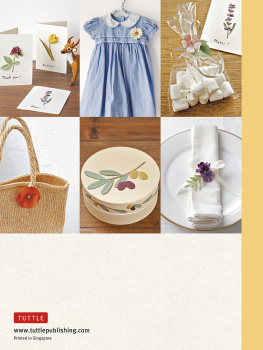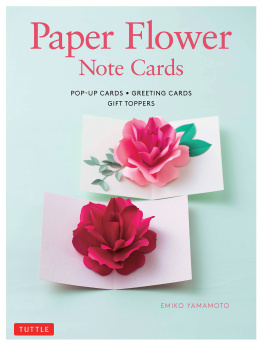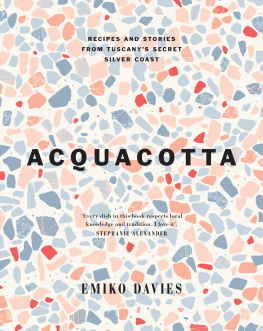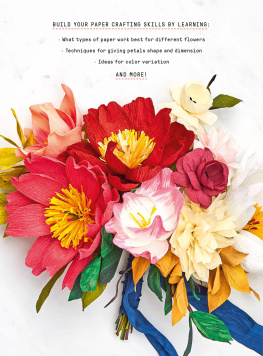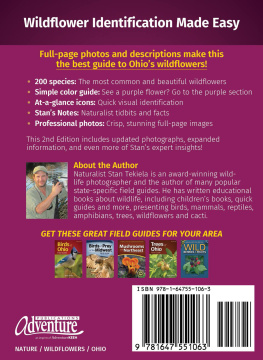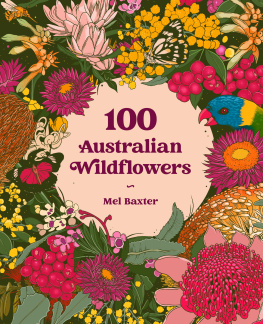Emiko Yamamoto - A Beginner’s Guide to Paper Wildflowers
Here you can read online Emiko Yamamoto - A Beginner’s Guide to Paper Wildflowers full text of the book (entire story) in english for free. Download pdf and epub, get meaning, cover and reviews about this ebook. publisher: Tuttle Publishing, genre: Home and family. Description of the work, (preface) as well as reviews are available. Best literature library LitArk.com created for fans of good reading and offers a wide selection of genres:
Romance novel
Science fiction
Adventure
Detective
Science
History
Home and family
Prose
Art
Politics
Computer
Non-fiction
Religion
Business
Children
Humor
Choose a favorite category and find really read worthwhile books. Enjoy immersion in the world of imagination, feel the emotions of the characters or learn something new for yourself, make an fascinating discovery.
- Book:A Beginner’s Guide to Paper Wildflowers
- Author:
- Publisher:Tuttle Publishing
- Genre:
- Rating:4 / 5
- Favourites:Add to favourites
- Your mark:
- 80
- 1
- 2
- 3
- 4
- 5
A Beginner’s Guide to Paper Wildflowers: summary, description and annotation
We offer to read an annotation, description, summary or preface (depends on what the author of the book "A Beginner’s Guide to Paper Wildflowers" wrote himself). If you haven't found the necessary information about the book — write in the comments, we will try to find it.
A Beginner’s Guide to Paper Wildflowers — read online for free the complete book (whole text) full work
Below is the text of the book, divided by pages. System saving the place of the last page read, allows you to conveniently read the book "A Beginner’s Guide to Paper Wildflowers" online for free, without having to search again every time where you left off. Put a bookmark, and you can go to the page where you finished reading at any time.
Font size:
Interval:
Bookmark:

Wild f lowers
Transferring Patterns
illustrations or engravings, you will often see the main character surrounded by
wildlife and lots of plants. The pictures illustrate how the people who lived when
the book was publishedand certainly long before thathad been living with
and enjoying such plants as part of their everyday lives.
ones that are native to (or common to) Europe and North America. Some
may be very familiar to you, and others may seem more exotic. If you find a
flower that appeals to you, I hope you will make it, and then frame it, use it as a
corsage or perhaps give it to a friendwhatever strikes your fancy!
pages and find many enjoyable ways to use them.
goblet-shaped single flowers sometimes have
petals that curl outward. The outer petals can
be tinged with green.
from the Greek word muschos or musk, which refers to
their scent. They are perennial bulb plants that grow in
grassy areas and rocky, mountainous regions.
and spread during the seventeenth century from
the island of Sicily in Italy. It climbs by clinging to
things with its terminal tendrils.
be seen in abundance in the spring in many woodlands.
They form a blue carpet of flowers, which are called
bluebell forests.
medicinal herbs. The name comes from the Greek
word khamaimelon , which means earth apple,
and refers to its apple-like fragrance.
fragrant flowers are typically dark purple (there are also
white varieties), and measure around inches (1.5 cm)
in diameter. The leaves are heart shaped.
petals with 3 green sepals. The stems are short and
fleshy, as are the heart-shaped leaves.
region. The flowers resemble those of the pea plant,
and are small and purple. The mature seeds turn black
and burst out of their pods.
chrysanthemums, daisies are often seen growing as a
weed in Europe. The name comes from the Old English
word dgeseage , which means days eye.
little girls dress.
and the berries, when ripe, are bright red
(and poisonous!).
the flower was thought to resemble the bird in flight.
It is famous in Japan as the flower that Shizuka
Gozen, wife of noted twelfth century warrior
Minamoto no Yoshitsune, wrote a poem about for
her beloved husband.
many other parts of the world, the garlic mustard
belongs to the brassica family. The large leaves
are heart shaped, and smell like garlic when
crushedand taste like mustard!
Germany, the Netherlands, as well as parts of the
UK, Scandinavia and the United States. The small
blue-purple flowers grow in clusters.
along coastlines, as well as in inland mountainous
areas. The globular flowers grow in clusters and are
pleasantly fragrant.
are called climbing roses. There are many varieties,
including single bloom, semi-double bloom and
double bloom.
which means golden phoenix flower. Another
name for the plant, uma no ashigata , means horses
hoofprint, because the leaves that grow from the
base of the stems were thought to be hoof shaped.
like onions, and are used widely in cooking.
medicinal herb.
touch, affix the recipients favorite flower.
iconography, the Virgin Mary is often depicted holding
a white lily, a symbol of her purity.
berried and white-berried varieties. The berries
are used to make jams, jellies and fruit cordials.
the wild rose. Roses have a very long history of being
treasured by humanstheyve even been found in
Egyptian tombs from 7,000 years ago.
and medicinal qualities of lavender have been appreciated
since prehistoric times. The English name is thought to
have come from the French word lavande , which in turn
comes from the Latin lavare (washing), because the
plant was often used in bathwater infusions.
Europe. The stems are covered with coarse hairs,
and the leaves are deeply serrated.
Here its used as a simple decoration on a woven bag.
Europe, and it can reach a height of 3 to 15 feet (1 to 5
Font size:
Interval:
Bookmark:
Similar books «A Beginner’s Guide to Paper Wildflowers»
Look at similar books to A Beginner’s Guide to Paper Wildflowers. We have selected literature similar in name and meaning in the hope of providing readers with more options to find new, interesting, not yet read works.
Discussion, reviews of the book A Beginner’s Guide to Paper Wildflowers and just readers' own opinions. Leave your comments, write what you think about the work, its meaning or the main characters. Specify what exactly you liked and what you didn't like, and why you think so.

